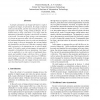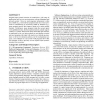93 search results - page 4 / 19 » Direct Segmentation for Reverse Engineering |
CVPR
2007
IEEE
14 years 9 months ago
2007
IEEE
Automatic annotation is an elegant alternative to explicit recognition in images. In annotation, the image is matched with keyword models, and the most relevant keywords are assig...
ER
2005
Springer
14 years 1 months ago
2005
Springer
Abstract. Understanding a large schema without the assistance of persons already familiar with it (and its associated applications), is a hard and very time consuming task that occ...
SIGSOFT
2008
ACM
14 years 8 months ago
2008
ACM
Program input syntactic structure is essential for a wide range of applications such as test case generation, software debugging and network security. However, such important info...
INDIASE
2009
ACM
14 years 2 months ago
2009
ACM
When trying to reverse engineer software, execution trace analysis is increasingly used. Though, by using this technique we are quickly faced with an enormous amount of data that ...
ICSE
2008
IEEE-ACM
14 years 7 months ago
2008
IEEE-ACM
Understanding the structure of large existing (and evolving) software systems is a major challenge for software engineers. In reverse engineering, we aim to compute, for a given s...


